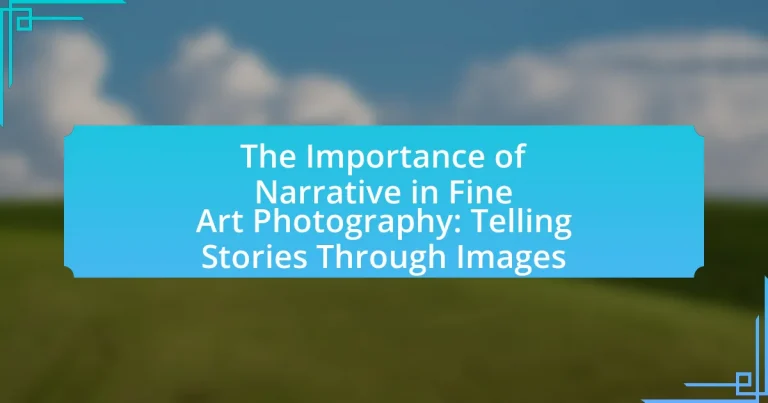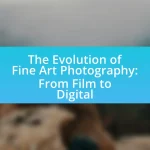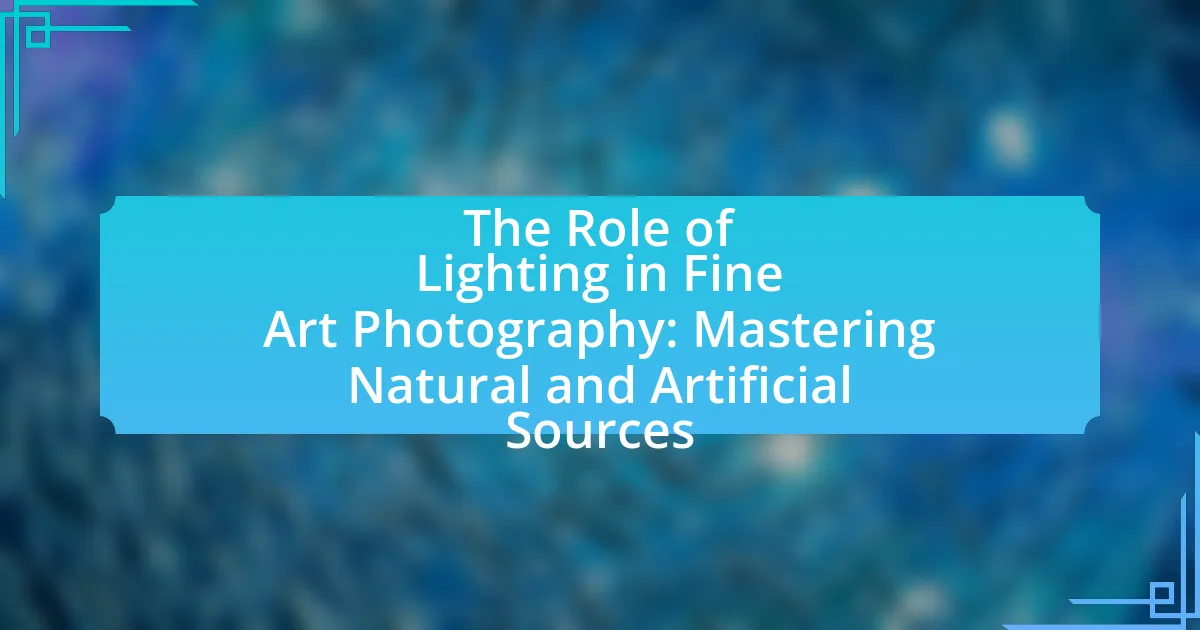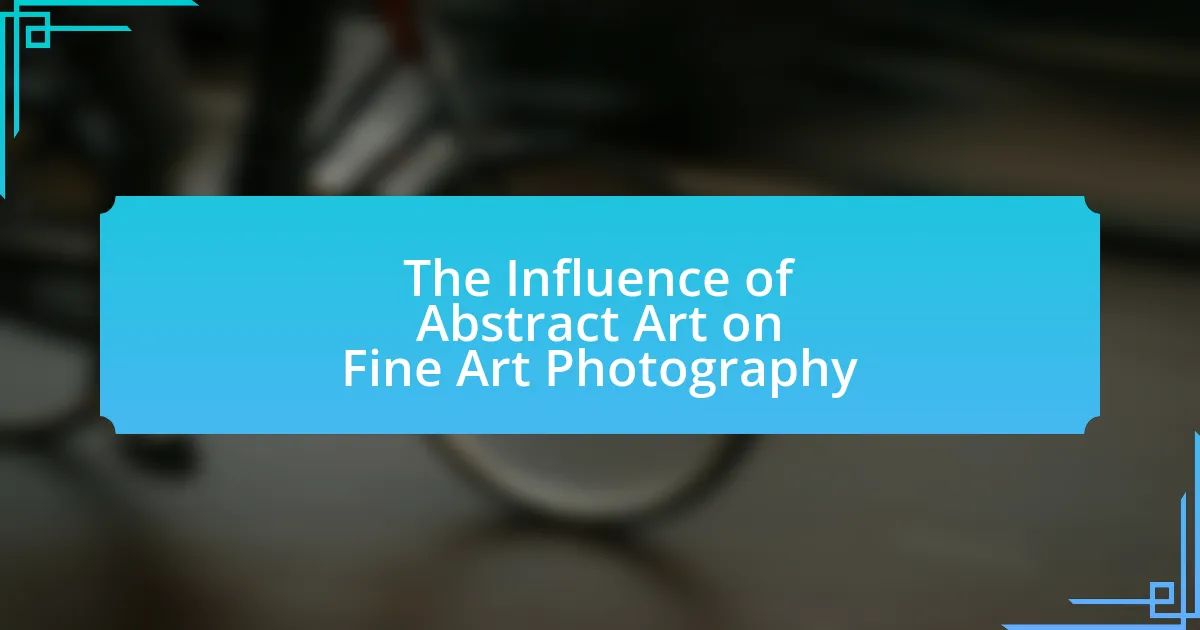The article explores the significance of narrative in fine art photography, emphasizing how storytelling enhances viewer engagement and emotional connection. It discusses the elements that contribute to effective storytelling, including composition, subject matter, lighting, and context, and examines the role of emotions in shaping narratives. Additionally, the article highlights techniques photographers can use to convey narratives, the impact of context and setting, and the importance of clarity and emotional resonance in visual storytelling. Practical tips for improving narrative skills and developing a personal style are also provided, along with exercises to practice narrative development in photography.
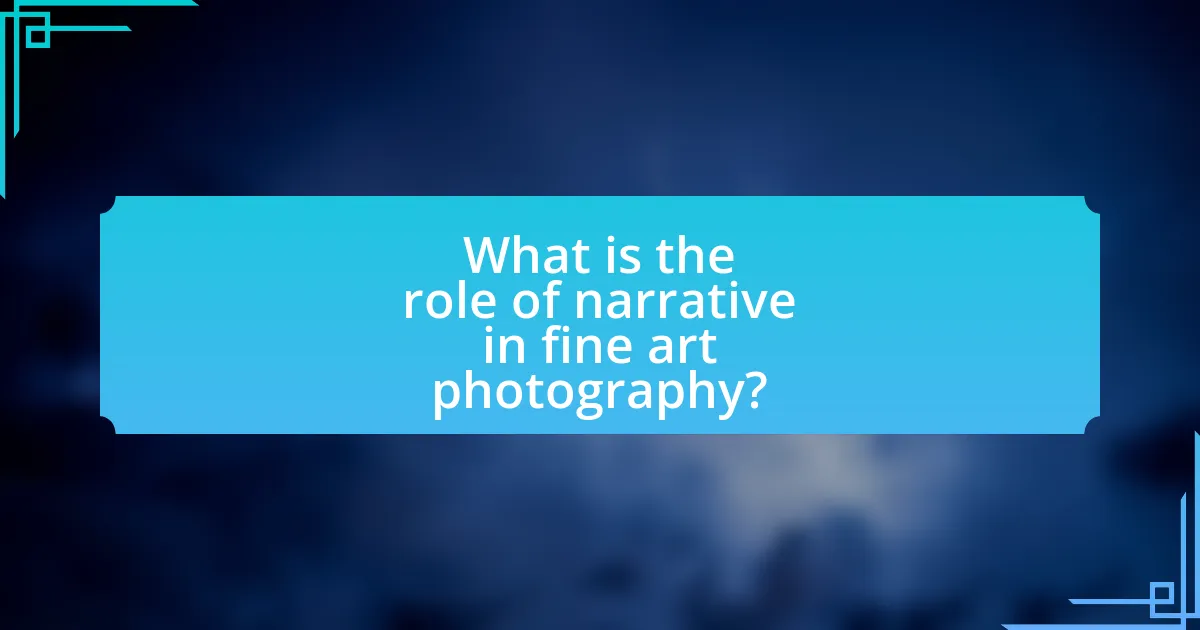
What is the role of narrative in fine art photography?
The role of narrative in fine art photography is to convey stories and emotions through visual imagery. This narrative aspect allows photographers to engage viewers on a deeper level, prompting them to interpret and connect with the artwork. For instance, renowned photographer Gregory Crewdson uses elaborate staged scenes to create cinematic narratives that evoke a sense of mystery and intrigue, demonstrating how storytelling can enhance the viewer’s experience and understanding of the image.
How does narrative enhance the viewer’s experience in fine art photography?
Narrative enhances the viewer’s experience in fine art photography by providing context and emotional depth to the images. When a photograph tells a story, it invites viewers to engage more deeply, prompting them to interpret the scene and connect with the emotions conveyed. Research indicates that images with a clear narrative can evoke stronger emotional responses, as demonstrated in studies where participants reported higher levels of engagement and empathy when viewing narrative-driven art compared to purely aesthetic images. This connection fosters a more immersive experience, allowing viewers to explore themes, characters, and settings that resonate with their own experiences or imaginations.
What elements contribute to storytelling in fine art photography?
Elements that contribute to storytelling in fine art photography include composition, subject matter, lighting, and context. Composition guides the viewer’s eye and establishes relationships between elements, while subject matter conveys themes and emotions. Lighting enhances mood and atmosphere, influencing how the image is perceived. Context provides background information that enriches the narrative, allowing viewers to connect with the story being told. These elements work together to create a cohesive narrative that engages the audience and evokes emotional responses.
How do emotions play a role in the narrative of fine art photography?
Emotions are central to the narrative of fine art photography as they evoke responses that deepen the viewer’s engagement with the image. Fine art photographers often utilize composition, color, and subject matter to elicit specific feelings, guiding the audience’s interpretation and connection to the artwork. For instance, a photograph depicting solitude may use stark contrasts and desaturated colors to evoke feelings of loneliness, while vibrant colors and dynamic compositions can convey joy or energy. Research indicates that emotional resonance in visual art can significantly enhance memory retention and personal connection, as seen in studies by Paul Ekman on emotional expression and perception. Thus, emotions not only enrich the narrative but also facilitate a more profound understanding of the themes presented in fine art photography.
Why is storytelling important in the context of fine art photography?
Storytelling is important in fine art photography because it enhances the emotional connection between the viewer and the artwork. This narrative element allows photographers to convey deeper meanings and provoke thought, transforming a mere image into a compelling story. Research indicates that images with a narrative context are more likely to engage viewers, as they invite interpretation and personal reflection, thereby enriching the overall experience. For instance, a study published in the Journal of Visual Culture highlights that photographs that tell a story can evoke stronger emotional responses compared to those that do not, demonstrating the power of narrative in visual art.
What impact does a strong narrative have on the interpretation of an image?
A strong narrative significantly enhances the interpretation of an image by providing context and emotional depth. When an image is accompanied by a compelling story, viewers are more likely to engage with it on a personal level, leading to a deeper understanding of its themes and messages. Research indicates that narratives can activate different cognitive processes, allowing individuals to connect emotionally and intellectually with visual content. For instance, a study published in the journal “Cognitive Science” by Green and Brock (2000) demonstrates that narratives can influence how people perceive and remember visual stimuli, suggesting that storytelling shapes the viewer’s experience and interpretation of images.
How can narrative influence the artist’s intent in fine art photography?
Narrative significantly influences the artist’s intent in fine art photography by shaping the thematic and emotional context of the work. When an artist incorporates a narrative, it guides the viewer’s interpretation and emotional response, allowing for a deeper engagement with the image. For instance, a photograph depicting a solitary figure in an urban landscape can evoke feelings of isolation or contemplation, depending on the narrative the artist intends to convey. This connection between narrative and intent is supported by studies, such as those by visual culture theorists, which highlight how storytelling elements in visual art can alter perception and meaning. Thus, narrative serves as a crucial tool for artists to communicate their vision and provoke thought in their audience.
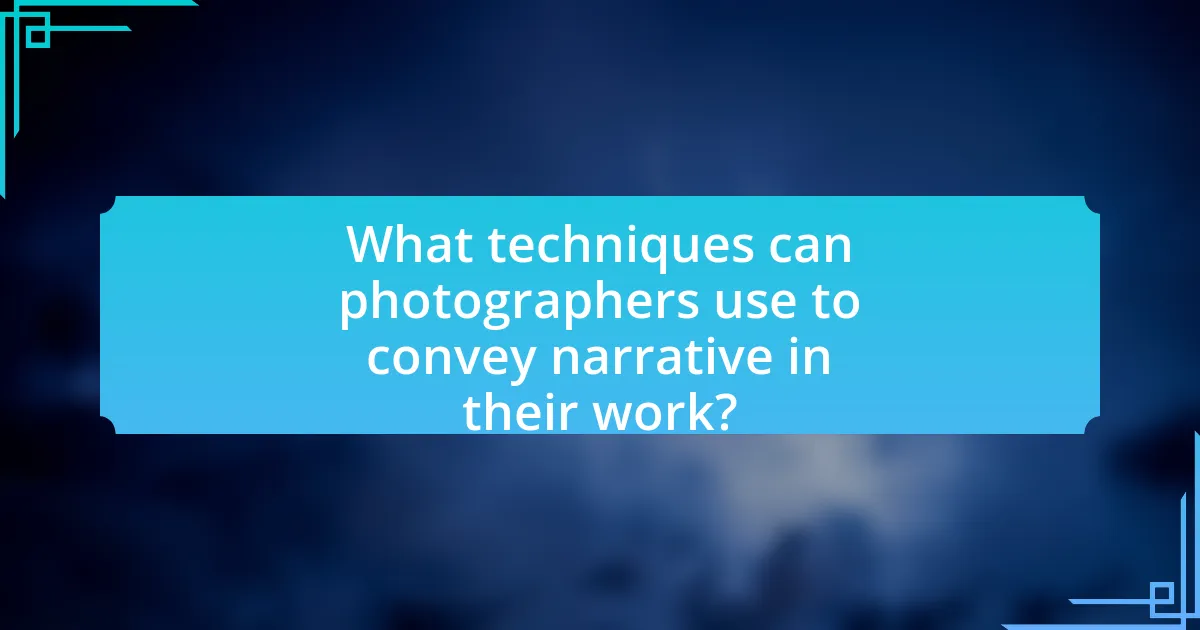
What techniques can photographers use to convey narrative in their work?
Photographers can use techniques such as composition, lighting, and subject matter to convey narrative in their work. Composition guides the viewer’s eye and establishes relationships between elements, while lighting sets the mood and emphasizes specific details, enhancing the story being told. Subject matter, including the choice of people, objects, or environments, provides context and emotional depth, allowing viewers to interpret the narrative. For example, a photograph of a solitary figure in a vast landscape can evoke feelings of isolation or contemplation, effectively communicating a narrative without words.
How do composition and framing contribute to storytelling in photography?
Composition and framing are essential elements that significantly enhance storytelling in photography by guiding the viewer’s eye and establishing context. Composition involves the arrangement of visual elements within the frame, which can create a sense of balance, tension, or focus, thereby influencing the narrative conveyed. For instance, the rule of thirds can lead to a more dynamic image that draws attention to the subject, while leading lines can guide the viewer’s gaze through the story being told.
Framing, on the other hand, refers to how subjects are positioned within the photograph, often using elements within the scene to create a ‘frame within a frame.’ This technique can isolate the subject, adding depth and context, which enriches the narrative. For example, shooting through an archway can provide a sense of place and perspective, enhancing the story’s emotional impact.
Research by the University of California, Berkeley, highlights that effective composition and framing can evoke specific emotions and responses from viewers, reinforcing the narrative intent of the photographer. Thus, both composition and framing are not merely technical aspects but are integral to the storytelling process in photography, shaping how narratives are perceived and understood.
What are the best practices for using light and shadow to enhance narrative?
The best practices for using light and shadow to enhance narrative involve strategically manipulating these elements to evoke emotions and guide viewer interpretation. Photographers should consider the direction, quality, and intensity of light to create mood; for instance, soft, diffused light can convey tranquility, while harsh, direct light can suggest tension. Shadows can add depth and dimension, creating a sense of mystery or drama, as seen in the works of photographers like Ansel Adams, who utilized contrast to enhance the emotional impact of his landscapes. Additionally, using light and shadow to highlight specific subjects can draw attention to key narrative elements, effectively guiding the viewer’s focus and enhancing storytelling within the image.
How can color choices affect the narrative conveyed in fine art photography?
Color choices significantly influence the narrative conveyed in fine art photography by evoking specific emotions and setting the overall mood of the image. For instance, warm colors like red and orange can create feelings of passion or warmth, while cool colors such as blue and green often evoke calmness or sadness. Research indicates that color psychology plays a crucial role in how viewers interpret visual art; for example, a study published in the Journal of Experimental Psychology found that colors can alter emotional responses and perceptions of a scene. Therefore, the deliberate selection of colors in fine art photography not only enhances aesthetic appeal but also shapes the viewer’s understanding and emotional connection to the narrative being presented.
What role does context play in the narrative of fine art photography?
Context plays a crucial role in the narrative of fine art photography by shaping the viewer’s interpretation and emotional response to the image. The context includes the historical, cultural, and social background surrounding the photograph, which influences how the narrative is constructed and understood. For instance, a photograph taken during a significant historical event, such as the Civil Rights Movement, carries a weight of meaning that informs the viewer’s perception and emotional engagement. This contextual information can transform a simple image into a powerful commentary on societal issues, thereby enhancing its narrative depth.
How can location and setting influence the story told through an image?
Location and setting significantly influence the story told through an image by providing context that shapes the viewer’s interpretation. The geographical and environmental elements depicted can evoke specific emotions, cultural associations, and historical narratives. For instance, an image captured in a bustling urban environment may convey themes of isolation or connectivity, while a serene landscape can evoke tranquility or nostalgia. Research indicates that visual storytelling is heavily reliant on contextual cues; a study by the University of California found that viewers’ emotional responses to images are often guided by the setting, which can alter their perception of the subject matter. Thus, the location and setting serve as critical components in constructing the narrative within fine art photography.
What is the significance of subject matter in developing a narrative?
The significance of subject matter in developing a narrative lies in its ability to convey meaning and evoke emotions. Subject matter serves as the foundation upon which a narrative is built, guiding the viewer’s interpretation and engagement with the artwork. For instance, in fine art photography, the choice of subject—such as a solitary figure in an urban landscape—can illustrate themes of isolation or resilience, thereby shaping the story being told. Research indicates that specific subjects can trigger particular emotional responses; for example, images of nature often evoke feelings of tranquility and reflection. Thus, the subject matter is crucial in establishing context, enhancing the narrative, and facilitating a deeper connection between the artwork and the audience.
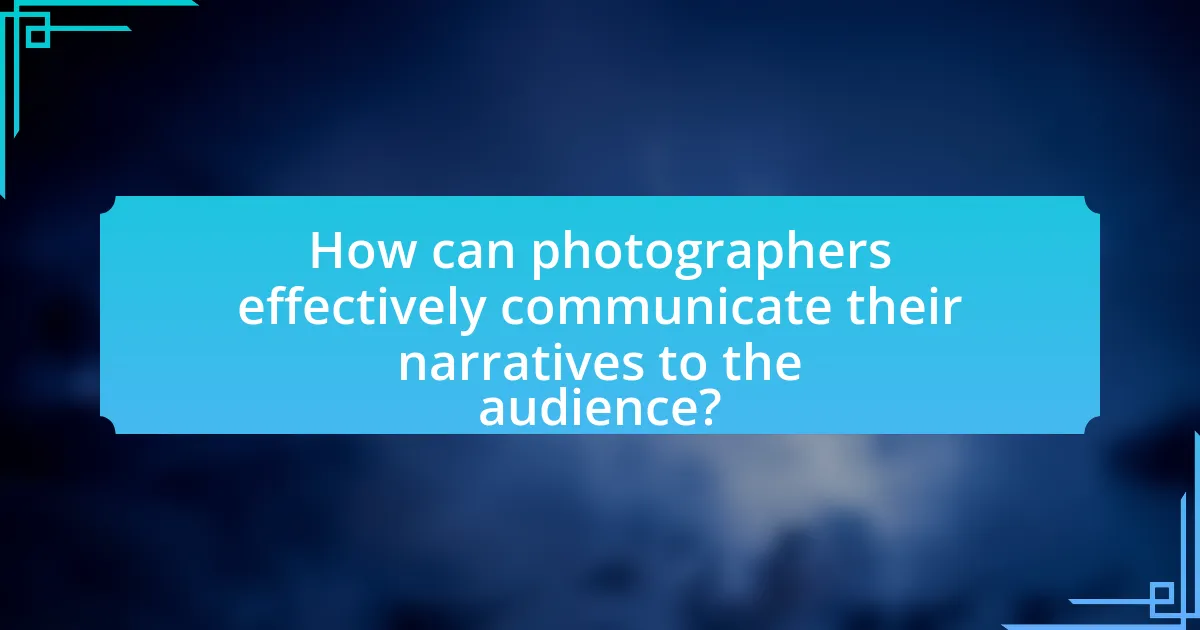
How can photographers effectively communicate their narratives to the audience?
Photographers can effectively communicate their narratives to the audience by utilizing visual storytelling techniques that engage viewers emotionally and intellectually. This involves selecting compelling subjects, employing strong compositions, and using lighting and color to evoke specific moods. For instance, a study published in the Journal of Visual Culture highlights that images with clear focal points and emotional resonance are more likely to elicit a narrative response from viewers. Additionally, incorporating context through captions or accompanying text can enhance understanding and deepen the narrative impact, as evidenced by research from the International Journal of Arts and Technology, which found that contextual information significantly influences audience interpretation of visual art.
What are the best ways to present a narrative in a photographic series?
The best ways to present a narrative in a photographic series include establishing a clear theme, using sequencing to create a flow, and incorporating visual elements that support the story. A clear theme provides a foundation for the narrative, guiding the viewer’s understanding and emotional response. Sequencing images strategically can evoke a sense of progression or transformation, enhancing the storytelling aspect. Additionally, visual elements such as color, composition, and subject matter should align with the narrative to reinforce the intended message. For instance, a study by the International Journal of Arts and Technology highlights that effective sequencing can significantly impact viewer engagement and interpretation, demonstrating the importance of these techniques in narrative photography.
How can captions and titles enhance the storytelling aspect of fine art photography?
Captions and titles enhance the storytelling aspect of fine art photography by providing context and guiding the viewer’s interpretation of the image. They serve as a narrative framework that can evoke emotions, provoke thought, and deepen the viewer’s engagement with the artwork. For instance, a title can hint at the underlying themes or concepts, while a caption can offer insights into the artist’s intentions or the circumstances surrounding the creation of the piece. Research indicates that viewers often rely on textual information to construct meaning, as demonstrated in studies showing that artworks accompanied by descriptive text are perceived as more meaningful and impactful. This interplay between visual and textual elements ultimately enriches the storytelling experience in fine art photography.
What role does exhibition design play in conveying narrative through photography?
Exhibition design plays a crucial role in conveying narrative through photography by creating an immersive environment that enhances the viewer’s experience and understanding of the images presented. Effective exhibition design utilizes spatial arrangement, lighting, and thematic organization to guide the audience through a curated story, allowing them to engage with the photographs on a deeper emotional and intellectual level. For instance, the layout can dictate the flow of movement, encouraging viewers to connect sequentially with the narrative, while strategic lighting can highlight specific elements within the photographs, drawing attention to key themes or emotions. This approach is supported by studies in museum studies, which indicate that well-designed exhibitions significantly improve visitor comprehension and retention of the narrative being conveyed.
What challenges do photographers face when trying to tell stories through images?
Photographers face several challenges when trying to tell stories through images, including conveying emotion, capturing context, and overcoming technical limitations. Conveying emotion is crucial, as images must evoke feelings that resonate with viewers; however, achieving this can be difficult due to varying interpretations of visual cues. Capturing context is another challenge, as photographers must provide enough background information within a single frame to ensure the story is understood, which often requires careful composition and timing. Technical limitations, such as lighting conditions and equipment constraints, can hinder a photographer’s ability to capture the desired narrative effectively. These challenges highlight the complexity of storytelling in photography, where both artistic vision and practical skills must align to create impactful images.
How can photographers overcome the limitations of visual storytelling?
Photographers can overcome the limitations of visual storytelling by integrating diverse narrative techniques, such as combining images with text, utilizing multimedia elements, and employing sequential storytelling. By incorporating text, photographers can provide context and depth that a single image may lack, enhancing the viewer’s understanding. For instance, photo essays often pair images with captions or narratives that guide the audience through the story, as seen in works by renowned photojournalists like James Nachtwey. Additionally, using multimedia elements, such as video or audio, can create a more immersive experience, allowing for a richer narrative. Sequential storytelling, where a series of images is presented in a specific order, can also effectively convey a progression of events or emotions, similar to how comic strips narrate stories through panels. These strategies collectively enable photographers to transcend the inherent limitations of static images and create a more compelling narrative experience.
What common pitfalls should photographers avoid when crafting narratives?
Photographers should avoid the pitfalls of lack of clarity, overcomplication, and neglecting emotional connection when crafting narratives. Lack of clarity can confuse the audience, making it difficult for them to understand the intended message. Overcomplication can dilute the narrative, leading to a loss of focus on the central theme. Neglecting emotional connection can result in images that fail to resonate with viewers, undermining the narrative’s impact. These pitfalls can hinder the effectiveness of storytelling in fine art photography, as clear, focused, and emotionally engaging narratives are essential for captivating an audience.
What practical tips can photographers use to improve their narrative skills in fine art photography?
Photographers can improve their narrative skills in fine art photography by focusing on composition, subject matter, and emotional resonance. Effective composition guides the viewer’s eye and creates a visual story; for instance, using the rule of thirds can enhance balance and focus. Selecting compelling subject matter that evokes emotion or curiosity engages the audience; for example, capturing candid moments can convey deeper narratives. Additionally, utilizing lighting and color can evoke specific moods, reinforcing the story being told. Research indicates that images with strong emotional content are more memorable and impactful, highlighting the importance of narrative in visual storytelling.
How can photographers develop a personal style that enhances their storytelling?
Photographers can develop a personal style that enhances their storytelling by consistently exploring and refining their unique vision, techniques, and subject matter. This involves identifying themes or narratives that resonate personally, experimenting with different compositions, lighting, and post-processing styles to create a cohesive body of work. For instance, renowned photographer Annie Leibovitz is known for her distinctive portrait style that combines dramatic lighting and intimate storytelling, which has become a hallmark of her work. By analyzing the impact of their choices on the viewer’s perception, photographers can further align their style with the narratives they wish to convey, ultimately creating a more engaging and meaningful visual story.
What exercises can help photographers practice narrative development in their work?
Photographers can practice narrative development through exercises such as creating a photo series, developing a storyboard, and engaging in visual storytelling prompts. A photo series allows photographers to explore a theme or concept over multiple images, effectively conveying a narrative arc. Developing a storyboard helps in planning the sequence of images, ensuring a coherent flow that enhances storytelling. Visual storytelling prompts, such as capturing a day in the life of a subject or documenting an event from different perspectives, encourage photographers to think critically about the narrative they wish to convey. These exercises are supported by the understanding that narrative structure is essential in visual art, as it guides the viewer’s emotional response and engagement with the work.












